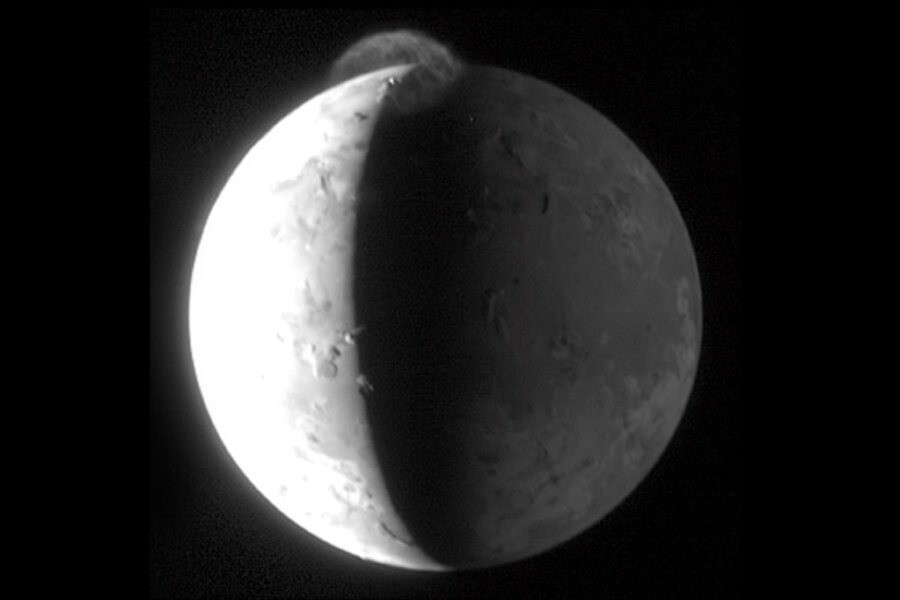Jupiter's other moon, the volcanic Io, could be a target for life
Loading...
When it comes to where extraterrestrial life might dwell in our own solar system, Jupiter's moon Europa often grabs the spotlight. However, its extraordinarily volcanic sibling Io might be a possible habitat as well.
A bit larger than Earth's moon, Io is the innermost of Jupiter's large satellites and the most volcanically active body in the solar system, with plumes of matter rising up to 186 miles (300 km) above the surface.
This extreme activity is the result of Jupiter's powerful gravitational pull, which causes Io's tormented solid crust to bulge up and down 328 feet (100 meters) or more, generating intense heat in Io due to friction. Although the heat near the volcanoes can reach some 3000 degrees F (1649 degrees C), high enough to keep lava liquid, Io's surface temperature averages at about negative 202 degrees F (-130 degrees C), leading to sulfur dioxide snowfields.
IN PICTURES: Jupiter
This means Io is a land of both fire and ice.
Io is generally considered a poor candidate for life because of all the radiation Jupiter blasts it with. In addition, no organic molecules have been detected on its surface, and it has only an extremely thin atmosphere devoid of detectable water vapor.
"Everyone right away tends to categorically exclude the possibility of life on Io," said astrobiologist Dirk Schulze-Makuch at Washington State University.
Still, conditions on Io might have made it a friendlier habitat in the distant past. If life did ever develop on Io, there is a chance it might have survived to the present day, Schulze-Makuch suggested.
"Life on the surface is all but impossible, but if you go down further into the rocks, it could be intriguing," he said. "We shouldn't categorize it as dead right away just because it's so extreme."
Computer models suggest Io formed in a region around Jupiter where water ice was plentiful. Io's heat, combined with the resulting possibility of liquid water, could have made life plausible.
"There must have been quite a lot of water on Io shortly after formation, judging from the amount of water ice on Europa and Ganymede," said Schulze-Makuch.
Jupiter's radiation would have stripped this water from Io's surface, perhaps within 10 million years. At this point life could have retreated underground, where water might still be abundant, and geothermal activity and sulfur compounds could provide microbes with sufficient energy to survive.
Although no organic molecules have been detected on the moon's surface, that does not mean they do not exist underground, Schulze-Makuch said. Any organic compounds that once existed on the surface or that may today still emanate from the subsurface – which probably were naturally present in this region of space during Io's formation – would get quickly destroyed by Jupiter's radiation.
The many lava tubes thought to exist on Io could serve as an especially favorable environment for life, Schulze-Makuch suggested, by protecting organisms from radiation.
The lava tubes also could provide thermal insulation, trapping moisture and providing nutrients such as sulfurous compounds. Microbes are common in lava tubes on Earth, from ice and volcano zones in Iceland to hot sand-floored tubes in Saudi Arabia, and lava tubes are the most plausible cave environment for life on Mars, he added.
The primordial soup that any life on Io might have originated from was likely based on water, but the solvent of choice for organisms there might have drastically changed later on as the moon transformed.
Hydrogen sulfide is one choice, as it is reasonably abundant in Io's shallow subsurface and remains liquid from negative 123 to negative 76 degrees F (-86 to -60 degrees C), falling within the environmental conditions that would prevail there. While it is not especially efficient as a solvent for ions, it does dissolve many substances, including many organic compounds. Other possibilities include sulfur dioxide and sulfuric acid.
"I'm exploring with colleagues whether sulfur compounds could work as solvents of life," Schulze-Makuch noted.
Given the wild extremes Io can swing through as it orbits Jupiter, one possible survival strategy for life in this challenging environment would be to remain dormant most of the time, only reverting back when nutrients were rich. "It'd be much easier for life to take a beating if it goes dormant regularly," Schulze-Makuch said.
Although Europa and Ganymede are higher priority targets for future exploration missions, Io should not be neglected, said Schulze-Makuch. "Much insight could be gained by sending a radiation-resistant robotic probe capable of detecting the chemistry and physical state of subsurface and surface liquids on Io," he noted, perhaps as part of a larger mission to the Jovian system.
"I know the chances of life on Io are low, and even if there is some microbial life in lava tube caves in its crust, in the short term there's no way for us to get there," he added. "But let's not totally exclude Io only because it seems strange or foreign."
If a mission to Io is extraordinarily lucky enough to find life in such an unlikely environment, "then it would make life elsewhere in the galaxy seem much more likely," Schulze-Makuch said. "It would really broaden our horizons."
Schulze-Makuch detailed his ideas in the February-March issue of the Journal of Cosmology.
- POLL: Will Scientists Find Alien Life in Our Solar System?
- Gallery: Moons of Jupiter
- Io's Lava Lakes Like Early Earth?
IN PICTURES: Jupiter





